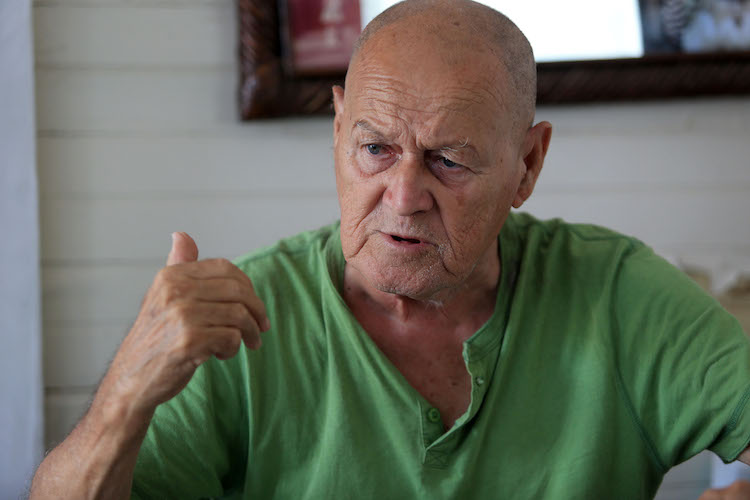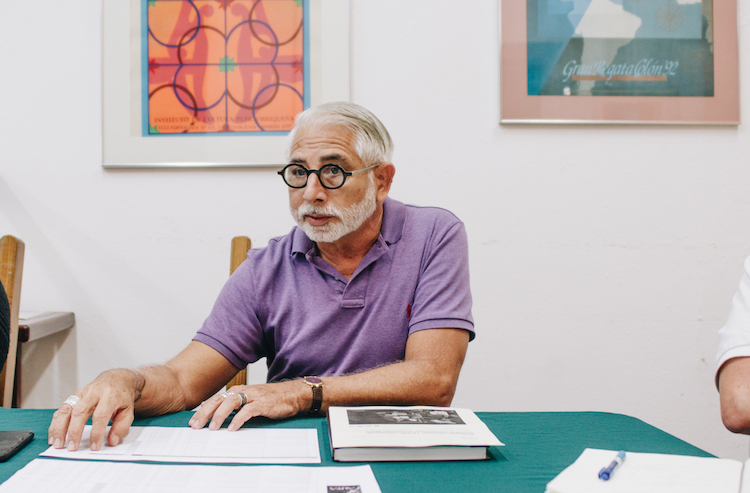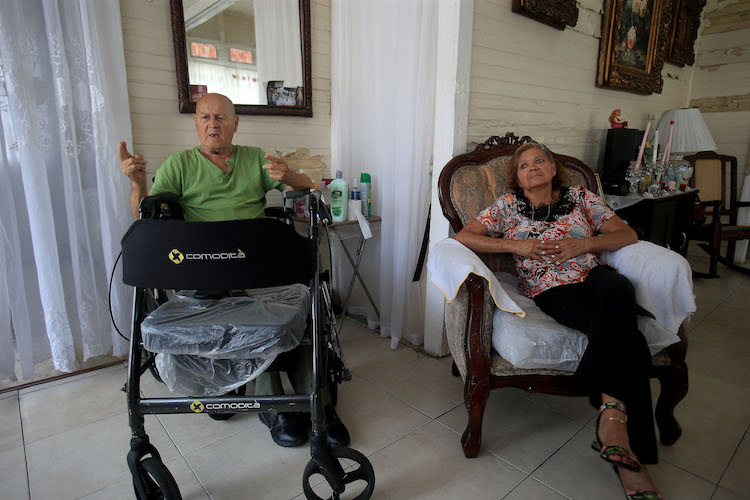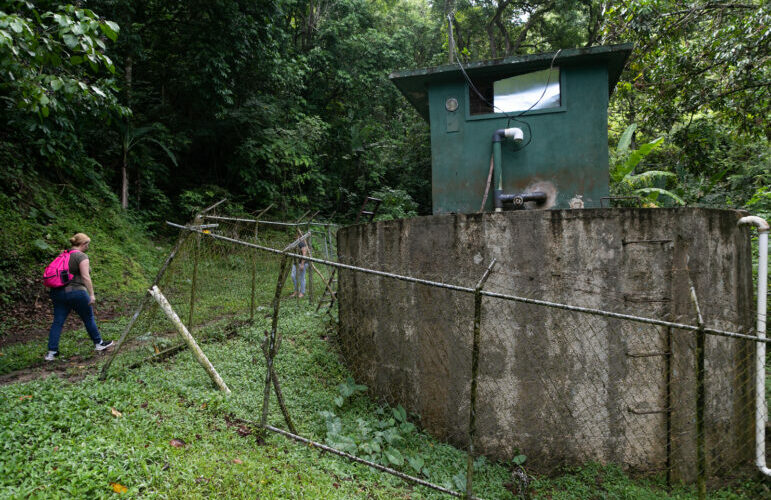Foto por Gabriel López Albarrán | Centro de Periodismo Investigativo
La casa de Rosa Ramos Burgos, en Aguirre, Salinas, quedó destruida luego del paso del huracán María.
She was sitting on the stairs of what had been her residence for almost four decades holding a photo album of the impressive historic mansion built in 1910 on the grounds of the Central Aguirre Sugar Mill in Salinas. Now there is only debris and some walls. There is no roof, no trace of the kitchen nor the living room. Some windows protect the main corridor. There is no furniture either. Hurricane María took them.
At 90 years-old Doña Rosa Ramos-Burgos never thought she would lack a roof over her head. In the blink of an eye, the hurricane destroyed the home that she has been unable to repair almost two years after Maria.
Doña Rosa is one of hundreds of elderly people who live in historic structures affected by Hurricane María and who, due to the lack of recovery funds, have not been able to repair their homes, since rehabilitation work in historic areas is highly regulated and prohibits interventions in structures that imply a change to what already exists.
This regulation, which seeks to preserve the historical value of these buildings, also increases the cost of rebuilding thousands of homes that were affected by the cyclone and whose repair implies a special restoration.
Angel Manuel Batista, 82, and Judith Sánchez, 72, spent the hurricane alone in their home on Montaner Street in Ponce’s historic center, a wooden structure built 100 years ago and where Mercedes Perez de Serrallés, matriarch of the Serrallés family, spent much of her life.
Located next to the Parque de los Próceres in Ponce, the damage caused by the hurricane is still evident 18 months after the hurricane. With great difficulty, the couple — who barely get by with what they receive from Social Security — used their money to pay to fix the roof. However, the repair does not stop water from leaking when it rains, although a blue tarp at least allows them to stay, hoping for help to repair it.
The lateral walls are perforated, the doors barely close, while the bedroom floors are giving way due to the obvious structural damage to the foundations. They sleep there with the risk that the structure will collapse at any moment.
Don Ángel, who has mobility problems due to his diabetic neuropathy condition, assures that they have never received help from the Federal Emergency Management Agency (FEMA) nor from the Historical Zone Office under the Office of Territorial Management of the Municipality of Ponce.
“FEMA have not come here… I went to the Municipality, to the Historical Zone [Office], and what did they tell me? They told me, ‘We don’t have money’, ‘there is no money to fix your house because your house is in bad shape.’ They just gave me problems. And how am I going to fix the house?” he questioned.

Photo by Gabriel López Albarrán | Center for Investigative Journalism
Ángel Manuel Batista denounced that he has not received financial help from any government entity to be able to repair his house in the historic area adjacent to the Parque de los Próceres de Ponce.
In Puerto Rico there are some 12 historic zones designated by the Planning Board, with the endorsement of the Institute of Puerto Rican Culture. A historic zone is designated by a set of structures that date back more than 50 years and share particular characteristics.
María Rodríguez, of the nonprofit organization PathStone, claimed there are no resources available to help families such as Doña Rosita and Don Ángel, seniors with limited resources, no technical assistance, and who don’t qualify for FEMA’s reconstruction program because the repair cost exceeds the funds available.
Rodríguez acknowledged that, like Don Angel and his wife Doña Judith, there are other people who live in historic areas and because of the damage caused by hurricane to their residence, they have no other option than to remain there facing risks because the assistance they received — if any — was minimal and they cannot rebuild or relocate.
PathStone, a nonprofit organization dedicated to strengthening communities and creating self-sufficiency through decent housing and employment opportunities, has oriented hundreds of locals facing this dilemma, most of them elderly and poor.
“We have clients who received minimal assistance for projects that require a lot of money and that require an expert in the preservation of historical structures. FEMA does not contemplate any of that and we have families that probably need more than $100,000 to preserve the historical structure, because they have no other alternative (to relocate),” Rodríguez said.
According to an inventory of damage after the cyclone, Hurricane Maria affected 361 of the 4,755 historic structures. The inventory was conducted by the organization Para la Naturaleza along with a group of volunteers students from the University of Puerto Rico’s School of Architecture.
In total, 22 structures in historical zones collapsed, 114 lost the roof or walls completely, 153 partially lost the roof or walls, and 72 structures suffered minor damages.
The findings of El Mapa de la Historia (History Map) showed that the area that suffered the most damage was located south of the eye of the hurricane and the most affected areas in Ponce, the Aguirre Historical Zone in Salinas, Guayama, Coamo and Arroyo. In Guayama alone, even with a well preserved historical zone, 122 structures received major damage and 14 collapsed.
Most of the historic buildings are private residences where recovery depends entirely on the owner due to lack of funds, the document updated to April 2019 concludes.
“FEMA’s financial assistance is not enough for the restoration. The forms do not provide a section to identify patrimonial structures. There are no protocols to address them. There is a prejudice against wooden structures and FEMA consultants don’t know how to deal with historical structures,” said Ivonne Sanabria, coordinator of Para La Naturaleza’s Cultural-Historical Affairs, who worked in the damage inventory of the “Mapa para la Historia.”
In April, the Central Recovery Office (COR3) announced the beginning of the evaluation process for the demolition of about 16,000 structures affected by the hurricane under the FEMA’s Debris Collection and Demolition of Private Structures Program. Up to $400 million could be assigned for the assessment, according to COR3. Twenty million dollars has been set aside for the first phase to evaluate the eligibility of the structures, the agency said.
Of those $20 million, $5.7 million has been allocated for the initial evaluation assigned to the Infrastructure Financing Authority (AFI) to determine if these structures meet the program’s requirements. The structures were originally identified by the municipalities .
So far it is unknown which structures are to be demolished and if among those there are buildings with historic value that, although they suffered damage with the hurricane, could be restored to preserve the historical heritage.
The secrecy of the process and the speculation about large interests that intend to develop new projects in high-value areas where these structures are located are of concern to the community that defends historic heritage, said architect Diana Luna-Serbiá.
This is coupled with an executive order signed by Gov. Ricardo Rosselló to streamline the demolition and debris removal process that allows government intervention in abandoned properties and authorizes municipalities to expropriate them without the owner’s consent.
Luna-Serbiá, president of the College of Architects and Landscape Architects explained that the endorsement of the U.S. Office of Historic Preservation and the Office of Built Historical Heritage of the ICP is required before the demolition of a historic structure.
However, a few months ago the latter seemed to be on the sidelines of the process since it had yet to receive the executive order. It was the private organizations and spokespersons of professional colleges dedicated to preservation that made the order, approved by Rossello on Nov. 13, 2018, available to them. “In February, they said they did not know that this was going to happen. That they had not received the executive order,” according to the architect.
The structures that would be demolished are those that were left inhabited. The architect’s concern is that this list includes buildings in historic areas such as urban centers that are of high value and that, although they can be rehabilitated, the government chooses to demolish them. The executive order authorizes municipalities to demolish structures without the owners consent if they consider them abandoned.
“The worst crime of that executive order is that it gives all the power to the municipalities to demolish structures without informing the owners. In the case of usufructs, the owners or heirs would not have the right to claim anything. Although it says there are going to be some revisions, experience tells us that there are no funds for the restoration,” Luna-Serbiá insisted. To make things worse, Puerto Rico has three different historical buildings listings: one federal, one from the Institute of Culture’s and the third, the registry of designated historical properties approved by the Planning Board. According to the architect this multiplicity does not help when deciding what criteria will be used to determine which structures will be considered of historical value.
She said the COR3 told her they had experts to evaluate the buildings, which in fact corresponds to the U.S. Office of Historic Preservation and the ICP’s Office of Built Historical Heritage.
Architect Pablo Ojeda, director of the ICP’s Office of Built Historical Heritage, pointed out that the process raises suspicion because his agency has not been included in the evaluation of the buildings.
“This is not a matter of declaring a moratorium in which everything goes, no. We have been very insistent that the Institute, as the entity that endorses projects and has the responsibility to watch over [the preservation of heritage], should be present and consulted,” he said.

photo by Mari B. Robles López
Pablo Ojeda, director of the Office of Historic Built Patrimony of the ICP, denounced that his office has not been included in the government efforts to recover historic buildings.
The agreement signed between FEMA and COR3 has the ICP as a “consulting partner,” which does not allow the same level of decision making, according to the ICP’s deputy director, Freddy Vélez. Since last summer, the ICP has insisted in changing the agreement to include the ICP as co-signer. So far, they have been ignored.
“We received a copy of the programmatic agreement between FEMA, State Historic Preservation Office (SHPO) and COR3. However, we expressed our disagreement, because we had previously communicated the intention that the ICP be part of it (attached is a copy of Freddy Velez, deputy director of the ICP’s, letter),” says an email sent by the ICP with the original version of the agreement of understanding and the amendments requested by the ICP.
Without specifying who is objecting, COR3 or FEMA, Carlos Ruiz, executive director of the ICP, said his agency’s official position is that it should be included in the agreement. “We are working on that. We hope to sign soon. They are two sister agencies. There should not be any problems,” he added.
For his part, Ojeda confirmed that the original list of about 16,000 structures includes historical buildings.
“A couple of months ago there was a meeting… from the beginning the ICP raised a red flag about this and about our wish to be involved in the process… The municipalities made a list of possible properties. Some have no historical value, others do… It’s complex because you have to go one by one,” said Ojeda.

Photo by Gabriel López Albarrán | Center for Investigative Journalism
The only repair that Ángel Manuel Batista and Judith Sánchez have been able to make two years after Maria has been on the roof. Even so, the centenary house in which they live has serious leaks every time it rains.
Since April 23 the Center for Investigative Journalism (CPI, for its initials in Spanish) has tried to gain access to the list of structures to be demolished but, neither FEMA nor government agencies have provided the document. In the case of COR3, there was also no response to an interview request.
COR3 Executive Director Omar Marrero, told CPI that he cannot make public the information about which structures were preliminarily identified to be demolished until the revision of the list is completed.
He said that in coordination with FEMA, AFI and the municipalities, he is looking into these buildings to see if they qualify for the proposed demolition; verifying if the residents have agreed to be relocated to proceed with the demolition, or if the property is not occupied.
“What we are going to do is to purge that list to finally confirm that the properties are eligible and that they have all the required approvals,” Marrero said.
Marrero assured that there should be no concern about the structures with historic value affected by the hurricane, since it will include an evaluation process in accordance with FEMA’s federal environmental laws governed by federal environmental and historic preservation regulations.
When asked why the ICP has not been formally included in the agreement to participate in the process, Marrero said that because there are federal funds involved, the ICP is not in charge of approval.
“The Institute of Culture is not the corresponding agency. The corresponding agency is the State Historic Preservation Office. A programmatic agreement with SHPO was signed to certify that everything was accomplished,” he insisted.
For his part, Juan A. Rosado-Reynés, spokesman for FEMA in Puerto Rico, confirmed that the COR3 provided a provisional list to the federal agency’s Debris Collection on Private Property Program team that included some 15,400 commercial or private properties.
These properties were proposed by the municipalities, either because they have large amounts of debris due to hurricane damage, or they have become unsafe structures that require demolition, or both.
According to FEMA spokesman in Puerto Rico, for these structures to remain on this list and be considered eligible to receive federal funds for demolition, the structure must constitute a risk to the health or safety of residents as a result of the hurricane.
“Once it is determined that the property or structure on the list meets all the criteria, it is referred to FEMA’s Environmental Planning and Historic Preservation sector to be rigorously evaluated in coordination with the SHPO regarding historical and environmental aspects. This part of the process is governed by a variety of federal and state environmental laws, as well as section 106 of the National Historic Conservation Act (NHPA),” he explained. So far, he said, he has not received an official list of any proposed site for evaluation for demolition or debris removal.

8 septiembre, 2022 LEER MAS